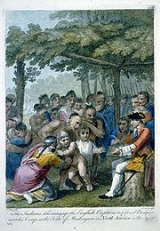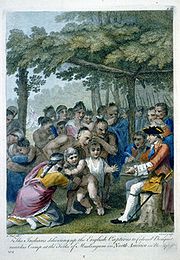
Captives in American Indian Wars
Encyclopedia
Treatment applied to captives in the American Indian Wars was specific to the local culture of each tribe. Captive adults might be killed, while children were, most of time, kept alive and adopted. History includes many examples of captives, and their associated treatment.
Some captives were adopted into their captors' tribe. Adoption frequently involved the captive receiving the name of a deceased member of the captors' tribe, and receiving the deceased's social status (i.e. becoming a member of the family of the deceased person). Children seem to have been invariably adopted, as were teenage girls.
Those men and women who were not adopted, as well as teenage boys , could also face the alternate fate of death by torture. The torture had strong sacrificial overtones, usually to the sun. Captives were expected to show extreme self-control and composure during torture, singing "death songs", bragging of one's courage or deeds in battle, and otherwise showing defiance. The torture was conducted publicly in the captors' village, and the entire population (including children) watched and participated. Common torture techniques included burning the captive- which was done one hot coal at a time, rather than the Hollywood-style pile of firewood around the captive - cuts from knives, beatings with switches and jabs from sharp sticks. Prisoners' fingernails were ripped out. Their fingers were broken, then twisted and yanked by children. Captives were made to eat pieces of their own flesh, and were scalped alive. To make the torture last longer, the Indians would revive captives with rest periods during which time they were given food and water. Tortures would begin with the lower limbs, then gradually spread to the arms, then the torso. The Indians spoke of "caressing" the prisoners gently at first, which meant that the initial tortures were designed to cause pain, but only minimal bodily harm. By these means, the execution of a captive, especially an adult male, could take several days and nights.
 Colonel Henry Bouquet
Colonel Henry Bouquet
set out from Fort Pitt on October 3, 1764, with 1,150 men. After that treaties had been negotiated at Fort Niagara
and Fort Detroit
, the Ohio Natives were isolated and, with some exceptions, ready to make peace. In a council which began on 17 October, Bouquet demanded that the Ohio Natives return all captives, including those not yet returned from the French and Indian War. Guyasuta
and other leaders reluctantly handed over more than 200 captives, many of whom had been adopted into Native families. Because not all of the captives were present, the Natives were compelled to surrender hostages as a guarantee that the other captives would be returned. The Ohio Natives agreed to attend a more formal peace conference with William Johnson, which was finalized in July 1765.
Cultural background
In the eastern woodlands cultural area (roughly encompassing the eastern one-half of the United States, and the southern portion of Quebec and Ontario), cultural traditions for dealing with captives predated the arrival of Europeans.Some captives were adopted into their captors' tribe. Adoption frequently involved the captive receiving the name of a deceased member of the captors' tribe, and receiving the deceased's social status (i.e. becoming a member of the family of the deceased person). Children seem to have been invariably adopted, as were teenage girls.
Those men and women who were not adopted, as well as teenage boys , could also face the alternate fate of death by torture. The torture had strong sacrificial overtones, usually to the sun. Captives were expected to show extreme self-control and composure during torture, singing "death songs", bragging of one's courage or deeds in battle, and otherwise showing defiance. The torture was conducted publicly in the captors' village, and the entire population (including children) watched and participated. Common torture techniques included burning the captive- which was done one hot coal at a time, rather than the Hollywood-style pile of firewood around the captive - cuts from knives, beatings with switches and jabs from sharp sticks. Prisoners' fingernails were ripped out. Their fingers were broken, then twisted and yanked by children. Captives were made to eat pieces of their own flesh, and were scalped alive. To make the torture last longer, the Indians would revive captives with rest periods during which time they were given food and water. Tortures would begin with the lower limbs, then gradually spread to the arms, then the torso. The Indians spoke of "caressing" the prisoners gently at first, which meant that the initial tortures were designed to cause pain, but only minimal bodily harm. By these means, the execution of a captive, especially an adult male, could take several days and nights.
1763 Pontiac's Rebellion

Henry Bouquet
Henry Bouquet was a prominent British Army officer in the French and Indian War and Pontiac's War. Bouquet is best known for his victory over Native Americans at the Battle of Bushy Run, lifting the siege of Fort Pitt during Pontiac's War.-Early life:Bouquet was born into a moderately wealthy...
set out from Fort Pitt on October 3, 1764, with 1,150 men. After that treaties had been negotiated at Fort Niagara
Fort Niagara
Fort Niagara is a fortification originally built to protect the interests of New France in North America. It is located near Youngstown, New York, on the eastern bank of the Niagara River at its mouth, on Lake Ontario.-Origin:...
and Fort Detroit
Fort Detroit
Fort Pontchartrain du Détroit or Fort Détroit was a fort established by the French officer Antoine de la Mothe Cadillac in 1701. The location of the former fort is now in the city of Detroit in the U.S...
, the Ohio Natives were isolated and, with some exceptions, ready to make peace. In a council which began on 17 October, Bouquet demanded that the Ohio Natives return all captives, including those not yet returned from the French and Indian War. Guyasuta
Guyasuta
Guyasuta was an important leader of the Seneca people in the second half of the eighteenth century, playing a central role in the diplomacy and warfare of that era...
and other leaders reluctantly handed over more than 200 captives, many of whom had been adopted into Native families. Because not all of the captives were present, the Natives were compelled to surrender hostages as a guarantee that the other captives would be returned. The Ohio Natives agreed to attend a more formal peace conference with William Johnson, which was finalized in July 1765.

